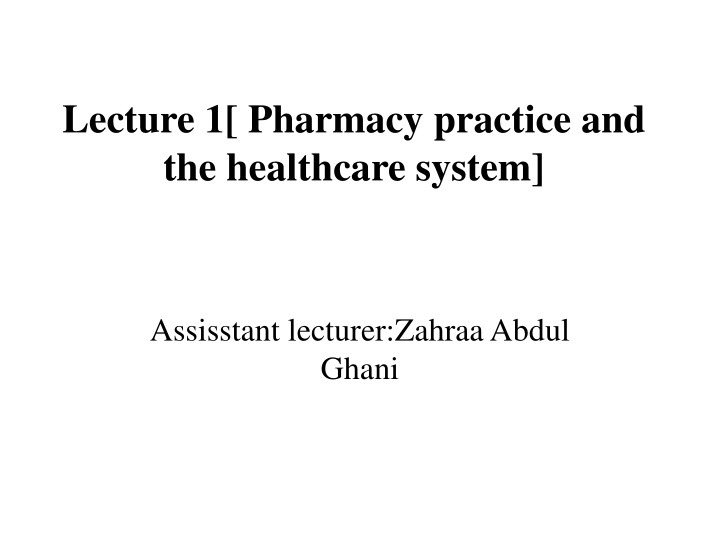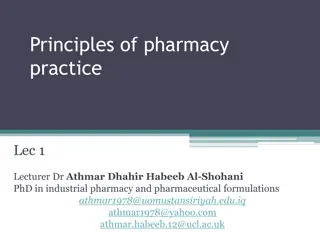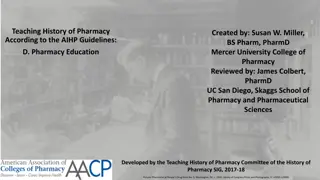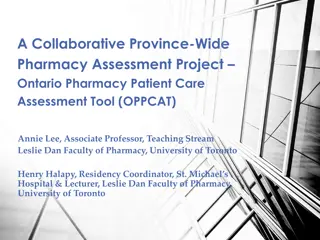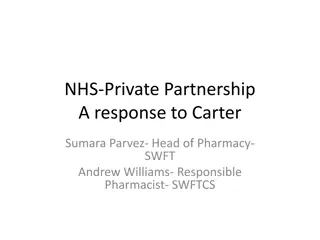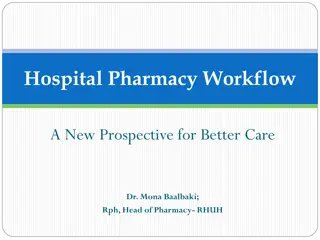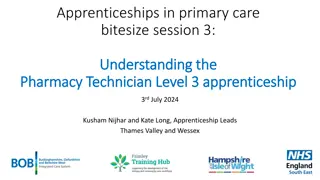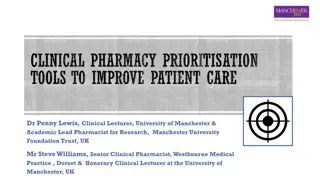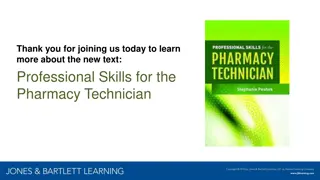Pharmacy Practice and Patient Care: A Comprehensive Overview
Pharmacy plays a vital role in patient care by contributing to health outcomes through management of medicines, chronic conditions, common ailments, promotion of healthy lifestyles, and support for healthcare professionals. Pharmacist interventions in the healthcare system ensure rational use of medicines, disease management, and efficient drug therapy. Patient pharmaceutical needs assessment helps tailor pharmacy services to individual patient groups based on specific requirements and access to pharmacy facilities.
Download Presentation

Please find below an Image/Link to download the presentation.
The content on the website is provided AS IS for your information and personal use only. It may not be sold, licensed, or shared on other websites without obtaining consent from the author.If you encounter any issues during the download, it is possible that the publisher has removed the file from their server.
You are allowed to download the files provided on this website for personal or commercial use, subject to the condition that they are used lawfully. All files are the property of their respective owners.
The content on the website is provided AS IS for your information and personal use only. It may not be sold, licensed, or shared on other websites without obtaining consent from the author.
E N D
Presentation Transcript
Lecture 1[ Pharmacy practice and the healthcare system] Assisstant lecturer:ZahraaAbdul Ghani
Impact of pharmacy on patient care There are five main areas in which pharmacy makes major contributions to health outcomes: 1- Management of prescribed medicines: drug development dispensing of medicine counselling 2- Management of chronic conditions: repeat prescribing monitoring therapeutic outcomes improvement in quality of life 3 -Management of common ailments: counselling recommendation of line of action .
4 -Promotion and support of healthy lifestyles: health education health screening 5- Advice and support for other healthcare professionals: provision of information on clinical and technical aspects of use of medicines participation in research and development programmes to transfer science into practice
Pharmacist interventions in the healthcare system Ensuring rational use of medicines: participation in the development of formularies, clinical guidelines and protocols, and analysis of prescribing information and drug use evaluation data. Disease management: contributing towards enhancement of compliance, adherence to evidence-based clinical guidelines and monitoring patient outcomes. Management of drug therapy: ensuring that safe and effective drug products are used and are accessible, collaboration with health professionals to ensure that prescribing is carried out for definite objectives, accessing patients profiles and medical records, undertaking counselling about safe use of drugs, patient monitoring to identify problems and suggest actions to solve problems.
Patient pharmaceutical needs assessment By identifying patients who would mostly benefit from pharmacist interventions, pharmacist-dedicated services can be directed towards individual patient groups to ensure minimal drain of resources while at the same time giving patients the pharmacy service particular to their needs.
The patient pharmaceutical needs assessment should take the following into consideration: Access to pharmacy facilities:Do patients who are house- bound have access to a pharmacist domiciliary service? Do patients visiting a pharmacy have access to the pharmacist? Do patients feel that they need more time with the pharmacist during outpatient visits at hospital clinics? Need for compliance aids:Do patients require memory aids or pill boxes to organise their medication? Social behaviour: Patients living on their own who may not have family or friends able to support them through their medication. Does the patient have special needs?
Identifying groups of patients with special needs 1 Patients suffering from certain diseases, such as: acute myocardial infarction chronic pain mental health problems learning difficulties
2 Age groups: extremes of age the young and the elderly 3 Drug treatment: narrow therapeutic index drugs expensive drugs: consider use of generic formulations what are the pharmaceutical implications of switching to a different pharmaceutical formulation? 4 Taking medicines for chronic disease: repeat prescriptions medication review 5 Patients in particular health settings: hospital, residential home, nursing home 6 Patients transferring from one health setting to another.
Achieving cost-effective patient care Within a healthcare system, pharmacists can participate in the four domains necessary for cost-effective patient care (Figure 2.1).
Quality assurance This establishes an acceptable level of performance and incorporates mechanisms to identify when that standard of performance is not met. Quality improvement This comprises information-driven processes that involve the implementation of monitoring procedures to ensure that adequate standards are obtained and maintained. It has two main components: total quality management (TQM) and continuous quality improvement (CQI). Total quality management (TQM) Defines measures of quality Measures current performance Analyses process Identifies improvement actions.
See Table 2.1 for a comparison of quality improvement and quality assurance. Measuring outcomes Use diagnostic results Use medical records Maintain databases that provide information to allow periodical reviews Assess patient satisfaction.
Assessing outcomes Clinical: response to treatment Functional: improvement in physical function Financial: cost-effective therapy Perceptual: patient s satisfaction with outcomes, care received and providers. Difficulties in implementation of outcomes management Compilation of data is time-consuming Resistance from health professionals.
Case example for quality assessment in a hospital Documentation and analysis of pharmacist intervention on the ward Cost-effectiveness study of medications used Patient satisfaction questionnaire developed to assess patient satisfaction with outcomes of therapy, care received, atmosphere on ward, communication with health professionals.
